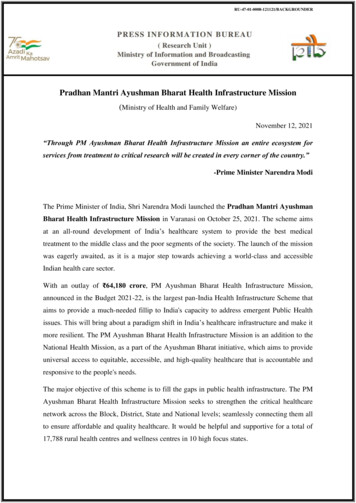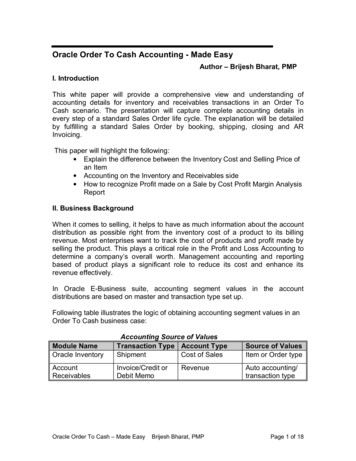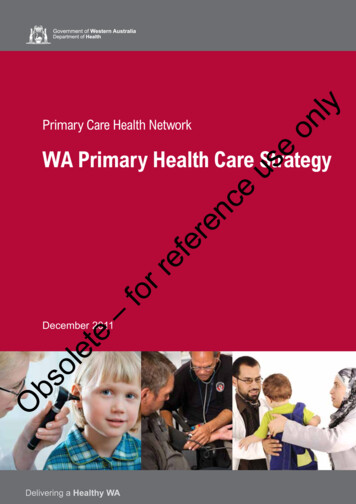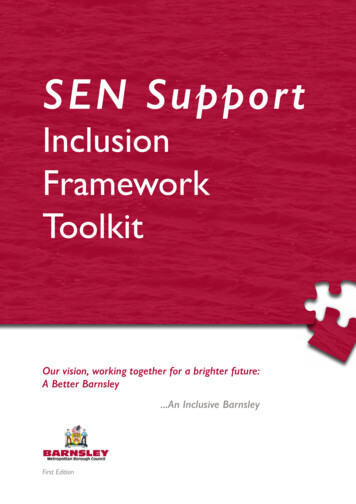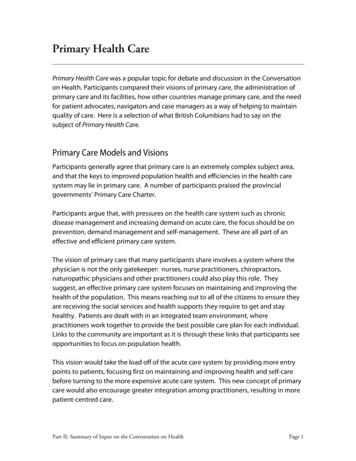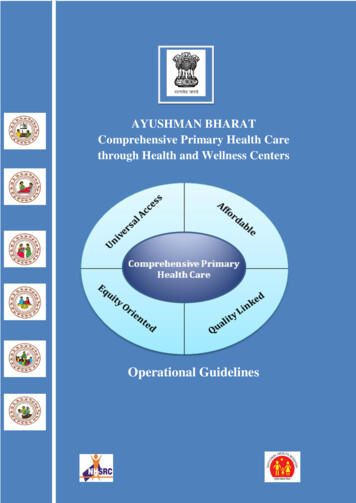
Transcription
AYUSHMAN BHARATComprehensive Primary Health Carethrough Health and Wellness CentersOperational Guidelines
Operational Guidelines, Health and Wellness Centres for Comprehensive Primary Health CareGlossary of iliary Nurse MidwifeAccredited Social Health ActivistAnganwadi CentresAyurveda ,Yoga and Naturopathy, Unani ,Siddha And HomeopathyBehaviour Change CommunicationBlock Community ManagerBlock Medical OfficerBlock Programme ManagerCommunity Health CentreCommunity Healthcare OfficerChronic Obstructive Pulmonary DiseaseCigarettes and Other Tobacco Products ActComprehensive Primary Health CareCorporate Social ResponsibilityDistrict Community ManagerDistrict HospitalDistrict Institute For Education and TrainingDistrict Programme ManagerEssential Medicines ListFirst Referral UnitGeneral Nursing And MidwiferyHuman Resource for HealthSub Health CentresIntegrated Child Development ServicesIntegrated Child Protection SchemeInformation Education CommunicationIndira Gandhi Matritva Sahyog YojanaIndira Gandhi National Open UniversityMahila Arogya SamitiMid Day MealMember of Legislative AssemblyMid Level Health ProviderMobile Medical UnitsMahatma Gandhi National Rural Employment Guarantee ActMedical OfficerMedical Officer In chargeMember Of ParliamentMultipurpose WorkerMen Who Have Sex With MenNational Aids Control OrganisationNon-Governmental OrganisationPage 2
Operational Guidelines, Health and Wellness Centres for Comprehensive Primary Health PHCVHSNCWCDNational Programme For Prevention And Control Of Cancer, Diabetes,Cardiovascular Diseases And StrokeOut of Pocket ExpenditureOut Patient DepartmentPrimary Health CentreReproductive and Child HealthSkilled Birth AttendantSelf Help GroupsState Health Systems Resource CentreStandard Treatment GuidelinesUniversal Health CoverageUrban Health and Nutrition DayUrban Local BodyUrban Primary Health CentreVillage Health Sanitation And Nutrition CommitteeWomen and Child DevelopmentPage 3
Operational Guidelines, Health and Wellness Centres for Comprehensive Primary Health CareContentsSection 1- Introduction . 05Section 2 - Defining Health Wellness Centres . 08Section 3 - Service Delivery and Continuum of Care . 14Section 4 - Human Resources . 24Section 5- Information and Communication Technology (ICT) . 31Section 6 -Planning, Location and Infrastructure Upgrade of Health and Wellness Centres . 35Section 7 – Medicines, Diagnostics and other Supplies. 39Section 8 – Quality of Care.42Section 9 - Health Promotion, Community Mobilization and Ensuring Wellness.44Section 10 - Programme Management.51Section 11 – Financing.56Annexure.59-82Page 4
Operational Guidelines, Health and Wellness Centres for Comprehensive Primary Health CareSection 1- IntroductionThe National Health Mission (NHM), the country’s flagship health systems strengtheningprogramme, particularly for primary and secondary health care envisages “attainment of universalaccess to equitable, affordable and quality health care which is accountable and responsive to theneeds of people”. Investments during the life of the NHM in its earlier phases were targeted tostrengthen Reproductive and Child Health (RCH) services and contain the increasing burden ofcommunicable diseases such as Tuberculosis, HIV/AIDS and vector borne diseases. While such afocus on selective primary health care interventions, enabled improvements in key indicatorsrelated to RCH and select communicable diseases, the range of services delivered at the primarycare level did not take into account increasing disease burden and rising costs of care on account ofchronic diseases.Studies show that 11.5% households in rural areas and about only 4% in urban areas, reportedseeking any form of OPD care - at or below the CHC level (except for childbirth) primary carefacilities, indicating low utilization of the public health systems for other common ailments1.National Sample Survey estimates for the period-2004 to 2014 show a 10% increase in householdsfacing catastrophic healthcare expenditures. This could be attributed to the fact that private sectorremains the major provider of health services in the country and caters to over 75% and 62% ofoutpatient and in-patient care respectively. India is also witnessing an epidemiological anddemographic transition, where non-communicable diseases such as cardiovascular diseases,diabetes, cancer, respiratory, and other chronic diseases, account for over 60% of total mortality. 2There is global evidence that Primary Health Care is critical to improving health outcomes. It hasan important role in the primary and secondary prevention of several disease conditions, includingnon-communicable diseases. The provision of Comprehensive Primary Health Care reducesmorbidity and mortality at much lower costs and significantly reduces the need for secondary andtertiary care. For primary health care to be comprehensive, it needs to span preventive, promotive,curative, rehabilitative and palliative aspects of care. Primary Health Care goes beyond firstcontact care, and is expected to mediate a two-way referral support to higher-level facilities (fromfirst level care provider through specialist care and back) and ensure follow up support forindividual and population health interventions.In India, the need for and emphasis on strengthening Primary Health Care was firstly articulated inthe Bhore Committee Report 1946 and subsequently in the First and Second National HealthPolicy statements (1983 and 2002). India is also a signatory to the Alma Ata declaration for Healthfor all in 1978. The Twelfth Five Year Plan identified Universal Health Coverage as a key goaland based on the recommendations of the High- Level Expert Group Report on UHC had calledfor 70% budgetary allocation to Primary Health Care in pursuit of UHC for India.1Key Indicators of Social Consumption in India on Health, National Sample Survey 71 st Round, 2014, Ministry ofStatistics and Programme Implementation, Government of India2WHO. Non Communicable Diseases; Country Profile for India; 2014Page 5
Operational Guidelines, Health and Wellness Centres for Comprehensive Primary Health CareThe National Health Policy, 2017 recommended strengthening the delivery of Primary HealthCare, through establishment of “Health and Wellness Centres” as the platform to deliverComprehensive Primary Health Care and called for a commitment of two thirds of the healthbudget to primary health care.In February 2018, the Government of India’s announced that 1,50,000 Health & Wellness Centres(HWCs) would be created by transforming existing Sub centres and Primary Health centres todeliver Comprehensive Primary Health care and declared this as one of the two components ofAyushman Bharat. This was the first step in the conversion of policy articulations to a budgetarycommitment.The Report of the Primary Health Care Task Force, Ministry of Health and Family Welfare,Government of India while reiterating that primary health care is the only affordable and effectivepath for India to Universal Health Coverage, also provided valuable insights into structure andprocesses that are required in health systems to enable Comprehensive Primary Health Care(CPHC).The delivery of CPHC through HWCs rests substantially on the institutional mechanisms,governance structures, and systems created under the National Health Mission (NHM). NHM, aspart of health system reform in the country, in its nearly 12 years of implementation, has supportedstates to create several platforms for delivery of community based health systems, expandingHuman Resources for Health and infrastructure towards strengthening primary and secondary care.Though largely limited to a few conditions, NHM created mechanisms for expanded coverage andreach, and developed systems for improved delivery of medicines, diagnostics and improvedreporting. About five years ago, these components were also introduced in urban areas.Thus, although the delivery of universal Comprehensive Primary Health Care, through HWCsbuilds on existing systems, it will need change management and systems design at various levels,to realise its full potential. The other component of Ayushman Bharat, namely the National HealthProtection Mission (NHPM) aims to provide financial protection for secondary and tertiary care toabout 40% of India’s households. Its success and affordability rests substantially on theeffectiveness of provision of Comprehensive Primary Health Care through HWCs. Together, thetwo components of Ayushman Bharat will enable the realization of the aspiration for UniversalHealth Coverage.1.1. About the GuidelinesThese guidelines were developed after consultation with policy makers and practitioners atnational and state level and with technical experts. It also draws on implementation experiences ofgovernment, NGO and private sector in the delivery of Primary Health Care. These guidelines areintended to serve as a framework for operationalizing the multiple components required for thedelivery of Comprehensive Primary Health Care services through the Health & Wellness Centres.These guidelines are expected to support programme managers at state and district levels in rollingPage 6
Operational Guidelines, Health and Wellness Centres for Comprehensive Primary Health Careout Comprehensive Primary Health Care. They provide an overview of the systems requirementsand strategies for change management to deliver CPHC.The use of these guidelines would enable the states to put in place the necessary design elementsand sub-systems required for Health and Wellness Centres to be created and deliver the healthservices expected of them. However, states have the flexibility to make necessary modificationsbased on their specific needs and capacities. The implementation of Comprehensive PrimaryHealth Care would require substantial change management in processes for planning, servicedelivery, monitoring and financing and will require the active participation of several stakeholdersincluding civil society, NGOs, academic and research agencies, development partners, the privatesector and, most importantly, the community. Operationalizing HWCs will be incremental innature with contextual variations in models and processes evolving in different states.These guidelines do not cover grounds included in several other guidelines already issued buthighlight areas in which transformation and change management is needed, besides clarifying keyconcepts related to Comprehensive Primary Health Care and Health and Wellness Centres.These guidelines are envisaged to be reviewed periodically and revised based on implementationlessons from the field so that they continue to provide meaningful and updated guidance toprogramme implementers and inform policy adaptation and modification.Page 7
Operational Guidelines, Health and Wellness Centres for Comprehensive Primary Health CareSection 2 - Defining Health Wellness Centres2.1. Key Principles1. Transform existing Sub Health Centres and Primary Health Centres to HWCs to ensureuniversal access to an expanded range of comprehensive primary health care services2. Ensure a people centered, holistic, equity sensitive response to people’s health needsthrough a process of population empanelment, regular home and community interactionsand people’s participation.3. Enable delivery of high quality care that spans health risks and disease conditionsthrough a commensurate expansion in availability of medicines & diagnostics, use ofstandard treatment and referral protocols and advanced technologies including ITsystems.4. Instil the culture of a team-based approach to delivery of quality health careencompassing: preventive, promotive, curative, rehabilitative and palliative care.5. Ensure continuity of care with a two way referral system and follow up support.6. Emphasize health promotion (including through school education and individual centricawareness) and promote public health action through active engagement and capacitybuilding of community platforms and individual volunteers.7. Implement appropriate mechanisms for flexible financing, including performance-basedincentives and responsive resource allocations.8. Enable the integration of Yoga and AYUSH as appropriate to people’s needs.9. Facilitate the use of appropriate technology for improving access to health care adviceand treatment initiation, enable reporting and recording, eventually progressing toelectronic records for individuals and families.10. Institutionalize participation of civil society for social accountability.11. Partner with not for profit agencies and private sector for gap filling in a range of primaryhealth care functions12. Facilitate systematic learning and sharing to enable feedback, and improvements andidentify innovations for scale up13. Develop strong measurement systems to build accountability for improved performanceon measures that matter to peopleIn order to ensure delivery of Comprehensive Primary Health Care (CPHC) services, existing Subhealth Centres covering a population of 3000-5000 would be converted to Health and WellnessCentres (HWC), with the principle being “time to care”- to be no more than 30 minutes. PrimaryHealth Centres in rural and urban areas would also be converted to HWCs. Such care could also beprovided/ complemented through outreach services, Mobile Medical Units, health camps, homevisits and community-based interaction, but the principle should be a seamless continuum of carethat ensures the principles of equity,quality, universality and no financial hardship.The HWC at the sub health centre level would be equipped and staffed by an appropriately trainedPrimary Health Care team, comprising of Multi-Purpose Workers (male and female) & ASHAsand led by a Mid-Level Health Provider (MLHP). Together they will deliver an expanded range ofPage 8
Operational Guidelines, Health and Wellness Centres for Comprehensive Primary Health Careservices. In some states, sub health centres have earlier been upgraded to Additional PHCs. SuchAdditional PHCs will also be transformed to HWCs.A Primary Health Centre (PHC) that is linked to a cluster of HWCs would serve as the first pointof referral for many disease conditions for the HWCs in its jurisdiction. In addition, it would alsobe strengthened as a HWC to deliver the expanded range of primary care services.The Medical Officer at the PHC would be responsible for ensuring that CPHC services aredelivered through all HWCs in her/his area and through the PHC itself. The number andqualifications of staff at the PHC would continue as defined in the Indian Public Health Standards.For PHCs to be strengthened to HWCs, support for training of PHC staff (Medical Officers, StaffNurses, Pharmacist, and Lab Technicians), and provision of equipment for “Wellness Room”, thenecessary IT infrastructure and the resources required for upgrading laboratory and diagnosticsupport to complement the expanded ranges of services would be provided. States could choose tomodify staffing at HWC and PHC, based on local needs.The HWC would deliver an expanded range of services (Box 2.2). These services would bedelivered at both Sub Health Centre (SHC) and in the PHCs, which are transformed as HWCs. Thelevel of complexity of care of services delivered at the PHC would be higher than at the sub healthcentre level and this would be indicated in the care pathways and standard treatment guidelinesthat will be issued .Box 2.2: Expanded range of servicesCare in pregnancy and child-birth.Neonatal and infant health care servicesChildhood and adolescent health care services.Family planning, Contraceptive services and other Reproductive Health CareservicesManagement of Communicable diseases including National Health ProgrammesManagement of Common Communicable Diseases and Outpatient care for acutesimple illnesses and minor ailments.Screening, Prevention, Control and Management of Non-Communicable diseasesCare for Common Ophthalmic and ENT problemsBasic Oral health careElderly and Palliative health care servicesEmergency Medical ServicesScreening and Basic management of Mental health ailmentsIn many states, the Primary Health Centre (PHC) would serve as the first point of referral andadministrative hub for sub health centres. However, in certain states, the sub health centre islinked directly to the Community Health Centre (CHC) at the block level (which in some blocks isa role performed by the Block PHC). Across all contexts however, it must be ensured thatadministrative, technical/mentoring and referral support be provided by a MBBS Medical OfficerPage 9
Operational Guidelines, Health and Wellness Centres for Comprehensive Primary Health Carein a facility that is in geographic proximity to the cluster of HWCs and is equipped to managereferral support for HWC. This could therefore be either a PHC or a CHC.Similarly, in the urban context, the Urban Primary Health Centres or Urban Health Posts, wherethey exist, would be strengthened as a HWC to deliver Comprehensive Primary Health Care. Thenorm of One MPW-(F) per 10,000 population supported by four-five ASHAs, will enable outreachservices, preventive and promotive care and home and community-based services. Therefore, inthe urban context, the team of MPWs (F) and ASHAs would be considered equivalent to a frontline provider team with the first point of referral being the UPHC catering to about at 50,000populations. All the key principles of HWCs indicated above will be applicable to PHCs in urbanareas. Initial action for upgrading U-PHCs to HWCs would require capacity building of staff andfield functionaries in the expanded range of services. Population enumeration, empanelment,disease screening would also be required. In many cities, where specialists’ consultation iscurrently being made available through evening OPDs on pre-fixed days, these could be leveragedas a strategy for ensuring continuity of care. However, states are free to undertake modificationsthat best fit their contexts.In planning for HWCs, states need to pay close attention to improving geographic accessibility,ensure the full complement of staff at each level, enable regular capacity building and supportivesupervision, ensure uninterrupted supply of medicines and diagnostics, and maintain a continuumof care seamlessly linking people to various levels of care so that the services offered at theprimary health care level fully meet the promise of expanded range and commensurate outcomes.As the principle of HWC is that they provide a continuum of care for all illnesses in thecommunity, strategic modifications of components of health systems at secondary and tertiarylevels and re-organization of workflow processes would be needed in parallel to effectivelyimplement Comprehensive Primary Health Care through HWCs.Clear demarcation of services that are provided in the Community, HWC and PHC/CHC levels isdifficult. Services provided at the primary health care level, are in fact, a shifting goal post,affected by a range of factors. However, this initiative under Ayushman Bharat, proposes to usediagnostic and technological innovation to bring services as close to people and communities aspossible. We need to recognize that poor service delivery at HWC will, adversely impact the gatekeeping role and push patients unnecessarily into costlier secondary and tertiary care facilities. Itcould also result in pushing patients to the private sector with adverse implications for out ofpocket expenditure and impoverishment.Figure 1 illustrates the key elements of HWC.Page 10
Operational Guidelines, Health and Wellness Centres for Comprehensive Primary Health CareFigure 1: Key elements of HWC2.2. Inputs for Health Wellness CentresThe key inputs to be provided at a HWC are listed below:2.2.1. Primary health care team to deliver the expanded range of servicesa. At the upgraded SHC- A team of at least three service providers (one Mid-levelprovider, at least two (preferably three) Multi-Purpose Workers – 2 Female and 1male, and team of ASHAs at the norm of one per 1000.b. At the strengthened PHC –PHC team as per IPHS standards. Although all thePHCs have been expected to provide 24*7 nursing care, this has not been possiblein several states for variey of reasons. In 24*7 PHCs having inpatient care, anadditional nurse should be posted where cervical cancer screening is beingundertaken/ planned. In PHCs that are not envisaged to provide inpatient care, theexisting nurses should receive modular training in certificate course for primarycare. In urban areas, the team would consist of the ANM (for10,000 population) andthe ASHAs (one per 2500).Page 11
Operational Guidelines, Health and Wellness Centres for Comprehensive Primary Health Care2.2.2. Logistics – Adequate availability of essential medicines and diagnostics to support theexpanded range of services, to resolve more and refer less at the local levels, and to enabledispensation of medicines for chronic illnesses as close to communities as possible.2.2.3. Infrastructure –Sufficient space for outpatient care, for dispensing medicines,diagnostic services, adequate spaces for display of communication material of healthmessages, including audio visual aids and appropriate community spaces for wellnessactivities, including the practice of Yoga and physical exercises.2.2.4. Digitization- HWC team to be equipped with Tablets/Smart Phones to serve a range offunctions such as: population enumeration and empanelment, record delivery of services,enable quality follow up, facilitate referral/continuity of care and create an updatedindividual, family and population health profile, and generate reports required formonitoring at higher levels.2.2.5. Use of Telemedicine/IT platforms: At all levels, teleconsultation would be used toimprove referral advice, seek clarifications, and undertake virtual training including casemanagement support by specialists.2.2.6. Capacity Building – Mid level health providers will be trained in a set of primaryhealthcare and public health competencies through an accredited training programme thatcombines theory and practicum with on the job training. Other service providers at HWCwill also be trained appropriately to deliver the expanded range of services.2.2.7. Health Promotion – Development of health promotion material and facilitation ofhealth promotive behaviours through engagement of community level collectives such as –Village Health Sanitation And Nutrition Committee (VHSNCs), Mahila Arogya Samiti(MAS) and Self Help Groups (SHGs), and creating health ambassadors in schools.Enabling behaviour change communication to address life style related risk factors andundertaking collective action for reducing risk exposure, improved care seeking andeffective utilization of primary health care services.2.2.8.Community mobilization, for action on social and environmental determinants, wouldrequire intersectoral convergence and build on the accountability initiatives under NHM sothat there is no denial of health care and universality and equity are respected.2.2.9. Linkages with Mobile Medical Units - Linkages with Mobile Medical Units couldserve to improve access and coverage in remote and underserved areas where there isdifficulty in establishing HWCs. In such cases, medicines and other support could beprovided to frontline workers, with periodic MMU visits. MMUs could also be linked tonearby HWCs, where medical consultation could be arranged on scheduled days, for thoseunable to travel to referral sites. MMUs could be used in conjunction with specific servicedelivery platforms, which otherwise are difficult to operationalize in that locality. MMUscan be designed to meet the specific needs in that locality- as a supplement to the HWCnetwork. The visit calendar of the MMUs would need to be planned and displayed at HWC.2.3. Financing: Suitable Payment mechanism for primary health care will need to be explored.Once the systems for population enumeration and record of services are streamlined, thepossibility of financing on a per capita basis can be explored. In addition, team basedincentives would be initiated. This will be done to facilitate accountability tooutputs/outcomes and provide individual centred care.Page 12
Operational Guidelines, Health and Wellness Centres for Comprehensive Primary Health Care2.4. Essential Outputs of HWC2.4.1. The HWC Data Base: Population enumeration and empanelment implies the creationand maintenance of database of all families and individuals in an area served by a HWC.This is planned such that every individual is empanelled to a HWC. This also involvesactive communication to make residents aware of this facility.2.4.2. Health cards and Family Health Folders: These are made for all service users toensure access to all health care entitlements and enable continuum of care. The health cardsare given to the families and individuals. The family health folders are kept at the HWC ornearby PHC in paper and/or digital format. This ensures that every family knows theirentitlement to healthcare through both HWC and the National Health Protection Mission orequivalent health schemes of state and central government.2.4.3. Increased Access to Services: HWCs would provide access to an expanded range ofservices indicated in Box 2.2. The availability of services would evolve in different statesgradually, depending on three factors- the availability of suitably skilled human resourcesat the HWC, the capacity at district/sub-district level to support the HWC in the delivery ofthat service, and the ability of the state to ensure uninterrupted supply of medicines anddiagnostics at the level of HWC. States will also have the flexibility to expand the range ofservice to address local health problems as defined by disease prevalence.2.5Outcomes2.5.1 Improved population coverage: Active empanelment and HWC database will improvethe population coverage. The HWC database would enable HWC staff to monitor andidentify the left out population and improve coverage of national health programmes.2.5.2 Reduced out of pocket expenditure and catastrophic health expenditure: Improvedaccess to expanded services closer to the community, assured availability of medicines anddiagnostic services and linkages for care coordination with Medical officers/specialistsacross levels of care will reduce financial hardships faced by community.2.5.3 Risk factor mitigation: Health promotion efforts by primary health care team wouldsupport in addressing the risk factors for diseases.2.5.4 Decongestion of secondary and tertiary health facilities: A strong network of HWCs atthe sub district level would facilitate resolving more cases at primary level and reduceovercrowding at secondary and tertiary facilities for follow up cases as well as serve a gatekeeping function to higher-level facilities.2.6Impact2.6.1 Improved population health outcomes: Improved availability, access and utilization willin turn contribute to equitable health outcomes measured through periodic population basedsurveys for key indicators listed in Section 10.1- Monitoring.2.6.2 Increased responsiveness: Provision of care by primary care team will be based onprinciples of family led care including dignity and respect for individuals and communitieswith particular focus on marginalized, information sharing, encouraging participation,including intersectoral collaboration that will lead to increased trust building, comfort inaccess to care and enable addressing social and environmental determinants.Page 13
Operational Guidelines, Health and Wellness Centres for Comprehensive Primary Health CareWhile not all inputs can be provided immediately, the state needs to have a road map for HWCstrengthening, in which some inputs can be added in an incremental manner. However, addition ofthe package of service for chronic conditions with requisite HR who is trained, and with themedicines and diagnostics would be a critical first step. The centres which do not fulfil all criteriabut have only initiated expanded service delivery, would be referred to as “HWCs – progressive,”and have a clear time line to become “fully functional HWC”- i.e., with the entire complement ofthe primary health care team, and delivery of the expanded range of services, identified forcomprehensive primary health care.Page 14
Operational Guidelines, Health and Wellness Centres for Comprehensive Primary Health CareSection 3 - Service Delivery and Continuum of Care3.1. Expanded Service Delivery3.1.1. Population Enumeration and Empanelment of Families at HWCThe Primary Health Care team at the HWC would serve as the fulcrum of a comprehensiveprimary care and support system, for planning, delivery and monitorin
AYUSHMAN BHARAT Comprehensive Primary Health Care through Health and Wellness Centers Operational Guidelines
